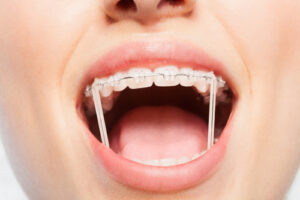 When it comes to the elements of orthodontics, there are elastics and there are rubber bands. Sometimes these terms are used interchangeably. Elastics often refer to the small, colorful bands that decorate each bracket. Elastics that connect top and bottom jaws are typically referred to as rubber bands. Whatever the wording, everyone needs some type of rubber bands or elastics when they have braces.
When it comes to the elements of orthodontics, there are elastics and there are rubber bands. Sometimes these terms are used interchangeably. Elastics often refer to the small, colorful bands that decorate each bracket. Elastics that connect top and bottom jaws are typically referred to as rubber bands. Whatever the wording, everyone needs some type of rubber bands or elastics when they have braces.
What Orthodontic Rubber Bands Do
Orthodontic rubber bands connect to small metal hooks on the brackets and are positioned in multiple ways to get the desired movement. Rubber bands usually target a misaligned jaw for patients who have an overbite, underbite, crossbite, or open bite. In some cases, rubber bands are used to adjust spacing between teeth or the positioning of a twisted or leaning tooth.
When Elastics Are Worn
Patients with conventional metal or clear braces will always have elastics to hold the wires and brackets together and shift their teeth into new positions. This is ends up being a fun part of the treatment for most people, especially kids, tweens, and teens. With a few dozen colors from which to choose, patients express themselves through their elastics, changing colors at every checkup.
How to Avoid Wearing Elastics
The only way to avoid wearing elastics or rubber bands during orthodontic treatment is to find out if you’re a candidate for Invisalign. This type of teeth-straightening method uses clear trays to align top and bottom teeth without elastics. Many Invisalign wearers do, however, have attachments – small, composite shapes temporarily bonded to their teeth that help the trays force teeth in the proper directions to straighten them.
How Long Rubber Bands Are Worn
Patients who need rubber bands typically begin wearing them in the middle of treatment, maybe six to eight months after they’ve begun. Whether you need rubber bands and when will depend on your specific treatment plan – some patients may only need them for weeks, others will require months to shift their alignment. The timing of their appearance on your braces is up to your orthodontist’s plan.
Changing Orthodontic Rubber Bands
Rubber bands stretch from the top jaw to the lower jaw on either side of the mouth. They exert force on teeth and jaw but this heavy work means the bands lose elasticity quickly. To keep pressure where it needs to be and minimize how long elastics need to be worn, rubber bands must be changed often, usually multiple times a day. It’s important to wear the bands around the clock to get the most benefit.
Daily Life with Orthodontic Elastics
Your orthodontist will guide you in how and when to wear your rubber bands. Wearing them 24 hours a day is the usual prescription, including during meals and sleep. If it’s difficult to eat easily or thoroughly clean teeth and hardware, you are likely to get the green light to remove the bands temporarily. Some elastics are arranged in such a way that makes both acts difficult with the rubber bands in place.
Rubber bands and elastics are simply part of the orthodontic journey – and the minor inconvenience of them is worth the amazing straight smile that results. If you or your teen is ready for braces, schedule a consultation at Soleil Orthodontics in Woodinville, WA, to learn more.

